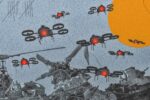Germany and the Netherlands have formalized a major joint procurement deal worth €4.5 billion for 222 new-generation SCHAKAL infantry fighting vehicles (IFVs), further expanding their fleets of Boxer 8×8 armored platforms. The move underscores growing European defense cooperation and reflects NATO’s push for rapid deployability and interoperable mechanized forces amid heightened security concerns.
Joint Procurement of 222 SCHAKAL IFVs Based on Boxer Platform
The German Federal Ministry of Defence (BMVg) and the Dutch Ministry of Defence have jointly signed a contract with ARTEC GmbH—a consortium led by Rheinmetall and Krauss-Maffei Wegmann (KMW)—for the production of 222 SCHAKAL IFVs. The total contract value is approximately €4.5 billion ($4.9 billion), with deliveries scheduled to begin in 2026 and continue through the early 2030s.
The SCHAKAL is a new variant of the proven Boxer multirole armored vehicle family, tailored specifically for infantry fighting roles with enhanced firepower, protection, and digital connectivity. According to Rheinmetall’s press release on October 10, 2025, this marks one of the largest single orders for Boxer-based variants to date.
Of the total order:
- Germany will receive approximately 150 vehicles
- The Netherlands will procure around 72 units
This joint acquisition is managed under OCCAR (Organisation Conjointe de Coopération en matière d’Armement), ensuring streamlined multinational coordination in design standardization and lifecycle support.
SCHAKAL Configuration: Firepower Meets Networked Warfare
The SCHAKAL variant is designed as a heavily armed infantry fighting vehicle leveraging modularity inherent to the Boxer platform. Key features include:
- Lance 2 Turret: A two-man turret developed by Rheinmetall featuring a stabilized 30 mm MK30-2/ABM autocannon capable of firing airburst munitions.
- Spike-LR ATGM Integration: Dual launchers for Rafael’s Spike-LR anti-tank guided missiles provide extended-range precision engagement against armor or fortified positions.
- Advanced Situational Awareness Suite: Includes EO/IR sensors, laser warning receivers (LWR), acoustic gunshot detection systems, and full C4I integration via NATO-standard BMS (Battle Management System).
- Active Protection System (APS): Though not officially confirmed for all units yet, Rheinmetall has proposed integration of its StrikeShield APS—a hybrid hard-kill/soft-kill system—for enhanced survivability against RPGs and ATGMs.
The vehicle retains high mobility thanks to its powerful MTU diesel engine delivering over 530 kW (720 hp), enabling speeds over 100 km/h despite its combat weight exceeding 38 tonnes in full configuration.
NATO Interoperability & Enhanced Mechanized Capabilities
This procurement significantly boosts NATO’s collective mechanized infantry capability by aligning German-Dutch formations under common vehicle platforms. Both nations are members of the Dutch-German Army Cooperation Initiative, which includes integrated units such as the German Panzergrenadierbrigade 41 operating under Dutch command structures since early 2023.
The use of identical platforms simplifies logistics chains, training pipelines, spare parts inventories, and tactical doctrine alignment across both armies—key advantages in high-intensity peer conflict scenarios envisioned by NATO planners.
Boxer Production Scaling Up Across Europe
The order will be fulfilled through ARTEC GmbH’s industrial partners across Germany (Rheinmetall Landsysteme/KMW) and Dutch subcontractors coordinated via Rheinmetall Nederland B.V., ensuring domestic industrial participation from both countries.
This follows recent expansions in Boxer production capacity across Europe:
- Lithuania: Ongoing delivery of Vilkas IFVs based on Boxer with Israeli turrets since late-2019
- UK: Over 500 Boxers ordered under Mechanised Infantry Vehicle program; production underway at RBSL Telford plant
- Australia: Over 200 CRV Boxers being delivered under LAND400 Phase II program with local assembly at MILVEHCOE facility in Queensland
SCHAKAL vs Other European IFVs: Strategic Choice or Stopgap?
The decision to expand investment into wheeled IFVs like SCHAKAL—rather than tracked platforms such as Puma or CV90—reflects operational priorities focused on mobility, strategic transportability within Europe’s road networks, and modularity for varied mission profiles including peacekeeping or hybrid warfare environments.
Skeptics argue that wheeled platforms may lack sufficient off-road performance or heavy armor protection compared to tracked equivalents in high-intensity combat zones like Eastern Ukraine. However, proponents highlight that modern wheeled designs like Boxer offer scalable armor packages (up to STANAG Level IV+), mine resistance comparable to MRAPs via decoupled drive modules, and superior operational readiness due to lower maintenance burdens.
Future Outlook: Digital Battlefield Integration & Export Potential
The SCHAKAL is expected to serve as a key node within digitally networked battlegroups using secure communications protocols such as Link-16/STANAG standards alongside national BMS suites like FüInfoSysH (Germany) or FOXTROT (Netherlands).
This order may also serve as a springboard for future exports or co-development programs with other NATO members seeking interoperable wheeled IFVs—particularly those already operating legacy Boxers or considering replacements for older M113/Marder-era fleets.
Apart from military utility, this deal reinforces European defense industrial sovereignty amid geopolitical uncertainty surrounding U.S. defense commitments post-2024 elections. It also aligns with EU PESCO goals emphasizing collaborative capability development among member states.









